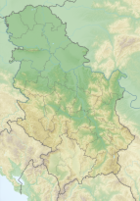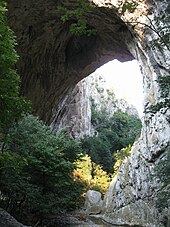Prerasti Vratne
|
Prerasti u kanjonu Vratne
|
||
|
Suva Prerast, the furthest of the three rock gates of Vratna |
||
| location | Vratna , Opština Negotin , Okrug Bor , Serbia | |
| surface | 145 ha | |
| WDPA ID | 328908 | |
| Geographical location | 44 ° 23 ' N , 22 ° 20' E | |
|
|
||
| Sea level | from 200 m to 250 m | |
| Setup date | 1957 | |
| administration | Institute for Nature Conservation of Serbia | |
The Prerasti Vratné ( Serbian - Cyrillic Прерасти Вратне , German rock plants of Vratna ) or rock gates of Vratna ( Vratnjanske kapije , Serbian - Cyrillic Вратњанске капије , English Vratna Gates ) are three rock gates near the medieval convent Vratna in the depths of Vratna- Gorge in Opština Negotin in Okrug Bor in eastern Serbia .
Details
Rock gates of this type are rare and can be found in a similar manner e.g. B. in Slovenia , France and in the United States in Colorado .
- The Mala Prerast ( German Small Rock ; also known as Mala kapija ) is located about 200 meters upstream from the Vratna Monastery and is 15 meters long. The width of the opening is 22 meters, the height 34 meters and the thickness of the arch above the opening 10 meters through which the Vratna River flows.
- The Velika Prerast ( German Great Rock ; also known as Velika kapija ) is located upstream about 100 meters from Mala Prerast and is 45 meters long. The width of the opening is 23 meters, the height 26 meters and the thickness of the arch above the opening 30 meters, through which the Vratna River also flows. The Velika Prerast is also known for its acoustics .
- The Suva Prerast ( German dry rock plant ; also known as Suva kapija ) is the most difficult to access. It lies another 3 kilometers upstream in a gorge and is 34 meters long. The width of the opening is 15 meters, the height 20 meters and the thickness of the arch above the opening is 10 meters. The name comes from the fact that the Vratna river falls 50 meters upstream in summer, but later reappears and disappears again before breaking out of the rock again and flowing on the surface.
Prerast (see прерасти ) means “outgrowth” or “overgrown” in Serbian. In this case, it is an indigenous term for these types of natural rock bridges, vaults, and gates.
reachability
A road leads across the village of Vratna to the monastery. The three rock gates can then be reached via a marked hiking trail that runs north of the monastery.
On the way to the first rock gate, a path branches off that leads to a hill with a summit cross, with a view of the monastery.
geology
The rock gates of Vratna are made of limestone from the Upper Jurassic and were created in different ways. The first two are the remains of a former cave tunnel through which the Vratna River flowed after part of the arch between them collapsed. The third arose from a rock collapse through which the river flowed. Erosion and the mechanical force of water shaped the gates to their present day appearance.
In the vicinity of the rock gates there are three karst caves, which are still largely unexplored. The largest cave is 400 meters long, another consists of a complex of tunnels and corridors, while the third is a small lake.
First descriptions
The first records of the rock gates come from the Austro-Hungarian ethnographer and traveler Felix Philipp Kanitz , who traveled to the Balkans in the 1850s and 1880s. He left a detailed representation of the rock gates. The Serbian geographers Vladimir Karić and Jovan Cvijić also examined the rock formation at the end of the 19th century. An exact measurement was carried out by Dragan Petrović and Dušan Gavrilović , professors at the Faculty of Geography at the University of Belgrade .
protection
The Vratna rock gates were placed under state protection in 1957 as geomorphological natural monuments . Wildlife includes red deer and mouflon , which were introduced here in 1965. There are also different species of bats and birds . Birds build their nests themselves in the cavities of the rock gates. There are also various medicinal plants . In the mid-2000s, almost all fish in the river died in severe droughts .
folklore
The local population tells numerous legends about the gates and the nearby caves. It is said that they are inhabited by kind-hearted nymphs who love to help people. Locals still come to pray by the gates or to make a wish.
literature
- Dénes Lóczy, Miloš Stankoviansky, Adam Kotarba (eds.): Recent Landform Evolution: The Carpatho-Balkan-Dinaric Region . Springer Science & Business Media, 2012, ISBN 978-94-007-2448-8 , pp. 366 ff . ( limited preview in Google Book Search [accessed January 29, 2020] illustrated).
Individual evidence
- ↑ a b c d e f Miroslav Stefanović: Занимљива Србија - Вратњанске капије: Три камена моста . In: Politika . No. 1097 , October 7, 2018, p. 20/21 (Serbian).
- ↑ DB: Kanjon Vratnem Vitki lukovi Prerasti. In: Planeta magazine. 2012, accessed December 12, 2019 (Serbian).



